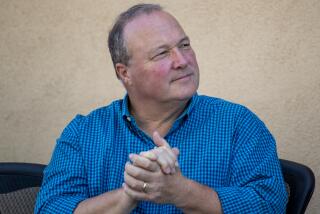Op-Ed: A 1930s California story shows why the war on drugs is a failure
For one bright and flickering moment last year, it looked like the global war on drugs was about to die. California – the sixth largest economy in the world – voted to fully legalize cannabis, while a smorgasbord of countries including Uruguay, Canada and Jamaica were also moving toward more sensible policies. But like Freddie Krueger after the nubile teenagers believe he is finally slain, the drug war is suddenly back with even sharper claws. Atty. Gen. Jeff Sessions is reviving the worst of the old policies that led to mass incarceration. President Trump has said that the Philippines is doing “a great job” on the drug war under a president, Rodriguo Duterte, who publicly boasts: “There’s 3 million drug addicts. There are. I’d be happy to slaughter them.”
To understand the likely consequences of this grim renaissance, we could wheel out the familiar arguments that have been around for decades now – but, buried in the forgotten history of California, there is a story that explains the situation better than any abstract case.
For most of the history of the United States, drugs were legal. People could buy opiates and cocaine-based products from their local pharmacy. An opiate-laced brew called Mrs. Winslow’s Soothing Syrup, for example, was particularly popular with housewives. One person who viewed this legal system with skepticism was a Los Angeles doctor named Henry Smith Williams. When a small number of his patients became addicted, he was disgusted, and he came to see them as despicable “weaklings.” So when opiates and cocaine were banned in 1914, he welcomed this first birth-pang of the drug war with glee.
Policies based on punishment and stigma will only make our drug problems spiral.
But then he noticed what happened to his addicted patients. They didn’t stop using. Instead, “here were tens of thousands of people, in every walk of life, frantically craving drugs that they could in no legal way secure,” he wrote in one of his books. “They craved the drugs, as a man dying of thirst craves water. They must have the drugs at any hazard, at any cost.”
At the same time, Smith Williams realized that the drug war was “in effect ordering a company of drug smugglers into existence.” Because pharmacists could no longer sell these drugs, the Mafia and other criminal organizations stepped in, selling a vastly inferior product at extortionate prices. In the pharmacies, morphine had cost two or three cents a grain, but the criminal gangs charged a dollar.
The death rate among addicts rose, and those who survived began to behave very differently. An official government study had found that, before the drug war kicked in, three-quarters of self-described addicts had steady and respectable jobs: some 22% were wealthy, while only 6% were poor. They were more sedate as a result of their addiction, but they were rarely out of control or criminal. Yet faced with the need to meet these extortionate new prices, many of the men started to commit property crimes, and many of the women started to steal or prostitute themselves.
So Smith Williams watched as the drug war created two waves of crime: first a wave of violent criminal drug-dealers, and then a wave of criminality among addicts. “The United States government,” Henry wrote in shock, had become “the greatest and most potent maker of criminals in any recent century.”
Because so many people noticed these effects, there was actually significant resistance to the early drug war across the United States. And some began to take advantage of a loophole in the legislation banning these drugs: Any doctor was free to prescribe heroin or cocaine to anyone who was addicted. Smith Williams’ brother, Edward, was one of the people who pioneered this approach in Los Angeles.
Henry described what he saw: When an addict came in, “the man is a wreck, at the verge of collapse,” Henry wrote. “He is deathly pale. Sweat pours from his skin. He is all a tremor. His life seems threatened.” But when he was given a legal prescription to meet his addiction, it would “restore him miraculously to a semblance of normality.” With help and support, they could then get back to a decent life.
Narcotics police began to shut down this loophole, state by state, actually rounding up 17,000 doctors nationally between the mid-1920s and the mid-1930s. In California, the success of the legal drugs program was so clear that many people fought back; the mayor of Los Angeles was one of its strongest defenders. But the feds came for California’s legal drug program too, and in the early 1930s Edward Smith Williams was arrested.
The reasons for this crackdown only became public years later, when they were established in a trial.
The head of the Narcotics Bureau in California in the 1930s, Chris Hanson, was approached one day by a local drug lord called Woo Sing. He pointed out that in states like Nevada, where the legal clinics had already been closed, addicts were forced to go to dealers; and he was furious that in California, the gangs couldn’t find customers because users and addicts could buy their drugs legally. So Woo bribed Hanson to introduce the drug war into California. Hanson was convicted of taking bribes – but the war on drugs he brought to California continues.
After learning all this, Henry Smith Williams realized he had been terribly wrong to demand a war on drugs, and he wrote a prophetic book called “Drug Addicts Are Human Beings” in which he opened his heart, and argued for a return to the system that had prevailed for most of U.S. history – a limited, licensed trade. He also predicted in the 1930s that if the drug war continued for another 50 years, there would be a $5-billion smuggling industry in the United States – and the journalist Larry Sloman later calculated that his prediction was eerily accurate.
Everywhere the drug war has been tried, it has had the effects that Henry Smith Williams witnessed at its birth. To resist the renewed push by Sessions and President Trump, we only need to remember what the people of California knew almost a century ago: Policies based on punishment and stigma will only make our drug problems spiral. The path back to sanity can only come through love, compassion – and a regulated trade.
Johann Hari is the author of “Chasing The Scream: The First and Last Days of the War on Drugs.”
Follow the Opinion section on Twitter @latimesopinion or Facebook
More to Read
A cure for the common opinion
Get thought-provoking perspectives with our weekly newsletter.
You may occasionally receive promotional content from the Los Angeles Times.










